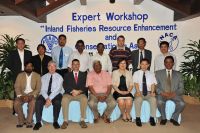Inland Fisheries Resource Enhancement and Conservation in Sri Lanka
2 July 2010 | Upali Amarasinghe | 4553 views | .mp3 | 5.96 MB | Genetics and Biodiversity, Inland aquaculture, Sri Lanka, Stock enhancement
Early attempts of fisheries enhancement in Sri Lankan freshwaters were aimed at establishing commercial fisheries and consequently, exotic cichlid species were introduced during the second half of the last century. A fisheries enhancement strategy was introduced to village reservoirs of the country in 1980s on a trial basis. This is termed as culture-based fisheries (CBF), which combines elements of aquaculture and capture fisheries and relies entirely on the natural productivity of the water body for growth of fish, and on artificial stocking as a means of recruitment. These efforts were however, unsuccessful under the technological and sociological milieu that prevailed, and further aggravated after the discontinuation of state patronage for inland fisheries and aquaculture development in Sri Lanka during 1990-1994. Presently, inland fisheries enhancement strategies in Sri Lanka are practiced in seasonal reservoirs and minor perennial reservoirs. The annual CBF production from these reservoirs is about 6 600 tonnes, accounting for about 17 percent of the inland fisheries production. The aquaculture extension officers of National Aquaculture Development Authority (NAQDA) and several NGOs have been conducting awareness programs to educate rural farmers on CBF management and development of business plans, facilitating inland fisheries resources enhancement in the country. The major seed resources for fisheries enhancement are fingerlings of Chinese and Indian major carps. State-owned aquaculture development centres (AQDCs) of NAQDA are responsible for induced breeding and rearing of post-larvae to fry stage. Community-based organizations (CBOs) and private pond owners have a significant role in fingerling rearing for fisheries enhancement. Although there has been a significant policy developments providing legal provisions for fisheries and aquaculture development in small reservoirs, in some parts of the country, CBF activity is still considered as a secondary use of reservoirs with low priority. Furthermore, possible impacts of fisheries enhancement on the biodiversity of native flora and fauna cannot be completely ignored and as such a procedure for impact assessment should be introduced. The provincial and central government fisheries authorities can play the role of project proponent and as part of the extension mechanism, for conducting EIAs or IEEs.
Creative Commons Attribution.
